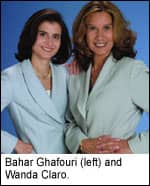by Wanda Claro, DDS, MS
The ongoing story of how two orthodontists learned to work together

While in my residency programs, I developed some idea of an ideal future partnership based on the mutual trust, great communication, and complementary social and work personalities. Of course, the residency orthodontic clinic allowed us to treat patients side by side. Because it was a university setting, there was much camaraderie, knowledge-sharing, teaching, and learning. I loved the intellectual, professional, and social stimulation.
My first position out of the orthodontic/pediatric dental specialty program was with a group practice as an associate, with the potential for partnership in the future. My partners and I soon found out that our personalities were not compatible, and that our management styles differed. I also did not like the fact that the office was sterilized only once a week and that no one wore gloves. I soon left this practice, with doubts about ever finding an ideal group situation.
I bought a part-time orthodontic practice 1 year out of residency and began my solo practice. After a couple of years, I shared space with an orthodontist who had another office in another county. He worked 1 day per week when I was not in. He eventually took over this office site when I moved into a larger space. I began my pediatric dental practice from scratch and word of mouth 2 years after I purchased the orthodontic practice. This part of the practice grew so fast that I soon brought in an associate to relieve me from working 6 days a week (not easy with three kids).
A year and a half later, I offered the pediatric dental practice to my associate to take over, and we moved into a larger office. We shared the leasehold improvements, the rent, utilities, my original equipment, telephones, paper goods, and similar dental supplies. We hired our own staff, and we bought our own equipment and specialized supplies. This arrangement was not the ideal one that came so easily in general practice, but it worked adequately until both of our practices outgrew the facilities.
Meeting the Right Person
It took me 2 years to find a place to relocate into. Within that 2-year period, I had received a resume from Bahar Ghafouri, DDS, MS, with a cover letter saying that she had been working in Los Angeles for more than 6 years, but recently had married and moved to Orange County, and was looking for a position there.
I was impressed by her credentials and leadership involvement in school. I didn’t have a position for her, but I had a friend who was looking for an associate with experience. I called Bahar to give her my friend’s name and phone number. (Fortunately for me, he had hired someone by then.) Many months later, I met her at an Orange County Women’s Dental Society meeting. She again impressed me as being very intelligent. She was young and stylish with a quick wit, a great British accent, and an aristocratic, mature, and confident air about her. She was still actively looking for something to open up in Orange County: either a location to start her own office, an associateship leading into a partnership, or a buyout. I shared my stories of being unsuccessful in finding space in Irvine, Calif, and wished her luck.
I met Bahar again in August 2002. I asked how her search had gone and if she was in her own practice. She said that she was considering an office that was in a beautiful setting but in a poor location. I excitedly told her that I had just found an office building to relocate into, and I had recently signed the lease. I had decided on my contractor and was in the process of finalizing the space-planning. She asked if I had considered bringing in a partner. I laughed off this suggestion. The debt for the construction and new equipment would be so high that it would be at least 5 years before I planned to bring in an associate, which would lead into a partnership and, eventually, my retirement.
Bahar convincingly said that since I had a successful practice, this would be an opportune time for a new person to come in to help build the practice and share in the expenses, rather than waiting 5 years, when the practice would possibly be valued at more than a beginning practitioner could afford. I said that I didn’t really know of anyone who could possibly handle this kind of venture, nor did I have the time or energy to begin a search in such a short time. She asked, “Why not me?” After the shock of not figuring this out for myself, I finally came to my business senses, and we set up a time for me to show her the building site and to talk further.
We reviewed the site and the preliminary office plans, and I showed her the office I was sharing. We discussed some treatment philosophies, shared personal information, and then decided to work with each other temporarily to decide if we could work with each other long-term. Before we began working with each other, Bahar suggested that we hire a consultant to guide us through the formalization of a specialized associateship agreement. It was obvious that Bahar had done her homework and was prepared for taking on this new venture.
The Prenup
Our agreement was short-term—we called it our “prenuptial” agreement. We gave ourselves a time frame of 4 months, with one 4-month extension to give us time to decide whether we should work together in an association, become partners, or stop the associateship altogether if we both felt it wouldn’t work.
The consultant spent time with us working on “talking points” and finalizing an outline for this associateship that we could give to an attorney to write up legally. These “talking points” included the following:
1) The nature of our relationship;
2) The schedule of services, and who sees new patients;
3) Emergency coverage;
4) Fees;
5) Compensation;
6) Licensure;
7) A termination clause;
8) Professional liability;
9) Records;
10) Expenses incurred by me or Bahar;
11) Vacation and time off;
12) A subcontractor clause;
13) A hold harmless agreement;
14) Written notices;
15) Standards of practice;
16) Policies and procedures;
17) A confidentiality clause;
18) Expenses for the contract;
19) Specific waivers;
20) An arbitration agreement; and
21) A postassociate relationship, including the begin- ning of a practice evaluation.
In addition, the consultant gave us a 31-page “Orthodontic Professional Questionnaire” that she had developed to assist owners and associates in evaluating their present and/or future professional relationship.
The questions covered the following areas:
1) Our personal and educational backgrounds;
2) Whether we rated our specific clinical and manage- ment skills as strong, average, or need improvement;
3) How we would treat specific cases, including technique preferred, timing of treatment, and length of treatment;
4) Short-range and long-range family and social/ community goals;
5) What motivates us;
6) What peeves us;
7) How to discuss disagreements;
8) Our thoughts about specific management and marketing;
9) Our relationships with staff and management, and our communication philosophies with staff;
10) Saturday and evening hours;
11) An on-call schedule;
12) Our scheduling ideals; and
13) Our goals for productivity.
Bahar and I had some laughs about the talking points, but now I realize that the consultant was forcing us to get to know each other—in a way that we would not do as fast when we would be working together only 1 day per week—to find out if we were compatible. I don’t think we ever finished writing or talking about everything on the list, but we got through enough to satisfy both of us.
We shared the same attorney for the associateship agreement, since we had hashed out what we both wanted with the consultant. During these proceedings, I realized how Bahar paid closer attention to legalese than I did. (Mostly, I didn’t know what some of it meant, but I didn’t question it.) She had a strength that I didn’t have—one that would become very beneficial later on.
While this process was going on, I was also working on the design of the new office. (The first one didn’t flow well, and the contractor was very adamant that he couldn’t and wouldn’t be able to do what I wanted.) I was also hiring another contractor (who did a terrific job!); hiring an interior designer; picking out equipment, office colors, flooring, countertops, cabinets, wallpaper, and paint—all while keeping up with a full load of patients in the existing building. Due to our busy schedules, it took us 3 months to work out an associateship agreement.
A New Beginning
Bahar began working for me 1 day per week in November 2002. In addition, she maintained her associateship 4 days per week, and taught at UCLA a half-day per week. She had to learn my practice routine, abbreviations, treatment cards, charts, protocol, computer systems, and staff-management techniques. She also had to listen to my construction and design woes. She witnessed many interesting staff dynamics, including one staff member quitting and another getting hired. As if that wasn’t enough, the permits to begin construction and the trenching of the floors began 11¼2 months after Bahar began her associateship. A great deal happened during the associateship time period, and before it ended we both decided that we would pursue a partnership.
Evaluating the Relationship
Then, the practice evaluation and demographic study began. Again, our consultant gave me a comprehensive questionnaire to complete.
We both felt that we possessed the qualities that are vital for a partnership to begin and to flourish:
1) Trust;
2) Agreement on common goals;
3) The ability to work together with respect and peace;
4) The ability to communicate effectively—even when we disagreed—and to respect each other after disagreeing;
5) Similar temperaments;
6) The ability to accept and embrace our differences;
7) The ability to compromise equitably and with equality;
8) Fairness and sincerity;
9) Honesty;
10) The ability to learn from each other;
11) The ability to jump in “the trenches”; and
12) A caring commitment to making it work.
My goals for the partnership were:
1) To build the practice enough to support two ortho- dontists in a quality-minded manner;
2) To offer more clinical hours for patients;
3) To reduce my number of hours working in and out of the practice so that I could take vacations more readily;
4) To earn a healthy income;
5) To save for retirement and my children’s educational needs;
6) To share in the practice’s administrative and financial responsibilities;
7) To learn from a “fresh” and intelligent partner;
8) To improve marketing and all areas of the practice; and
9) To have a retirement/transition strategy.
Bahar had the following goals:
1) To have an ownership and an administrative/manage- ment say in a high-quality practice that would allow her to increase the growth of the practice;
2) To begin a family, and to know that the practice would be covered by her partner;
3) To take vacations often;
4) To work part-time while her family was growing;
5) To have a healthy income;
6) To learn from a “seasoned” and reputable partner;
7) To improve marketing and all areas of the practice, and
8) To bring in an associate/partner in the future.
It took us another 2 months to complete the practice evaluation. In the meantime, Bahar and I discussed what type of partnership structure we would have, when I wanted to retire, how we would handle her maternity leave, our vacation times, compensation, the construction loan, and whether we would be a partnership or a corporation. Bahar decided to immediately become a 50% partner, and I agreed.
Our consultant did an analysis of the demographics of the old and new offices’ potential for growth, as well as their financial picture. Bahar and I decided to form a partnership of our professional corporations. Again, our consultant guided us through the creation of the partnership outline and the buy/sell agreement to give to my attorney. Once my attorney finished hashing through it, we made final alterations and signed it with our husbands at the AAO post-meeting on the Big Island of Hawaii in May 2003—a beautiful setting for a momentous occasion!
Moving In
When we returned from the AAO meeting, we had moved into the new office, but we still needed to complete many more partnership contingencies. These included adding Bahar to the lease, the construction loan, and the contractor’s agreement. We also updated our contact information with the supply companies, the insurance companies, and the computer practice-management system. We ordered new stationery and business cards, and we announced to our patients, referrals, staff, and the community that Bahar was my new partner. We needed to open a new bank account, change the merchant ID numbers and tax ID numbers, add each other to the risk-management and business-liability insurances, take out life insurance for each other, and do a myriad of other things that we had not anticipated.
We planned an open house for July 2003 to introduce Bahar to our referrals. These miscellaneous things took another 4–5 months to complete. In addition, we developed schedules and discussed the division of the administrative duties. Bahar gave notice to her associateship, began seeing new patients, and met with new practitioners in the area. She also became pregnant with her first child (who was born May 15, 2003). These were happy—yet stressful—events.
From our chance meeting in August 2002, Bahar and I managed to place ourselves on the fast track for assessing our personal and professional compatibility so that we were able to form an associateship that led to a partnership.
We have been through many ups and downs in the last 2 years, what with staff transitions, disagreements, and incompatibilities, an extended maternity leave, insurance changes, workers’ compensation issues, a breach of our exclusive clause in our building by our landlords, unexpected expenses, more orthodontists coming to the area, and other everyday kinks. However, we are committed, we trust each other, and we keep our ongoing goals in mind:
1) Offering our patients individualized service;
2) Marketing internally, professionally, and externally;
3) Continuing to train ourselves and our staff;
4) Fostering open communication with each other, our staff, our patients and parents, and our referrals;
5) Allowing for more time off to re-energize;
6) Earning an equitable income and developing retirement funds;
7) Increasing production;
8) Standardizing supplies, treatment techniques, and protocols; and
9) Continuing our heartfelt commitment to our practice and to each other.
Wanda Claro, DDS, MS, is in private practice in Irvine, Calif. She is a diplomate of the American Board of Orthodontics and a past president of the Southern California Bioprogressive Orthodontic Study Club. She can be reached at (949) 786-7800 or [email protected]. For more information, visit her Web site at www.irvineorthodontics.com.










